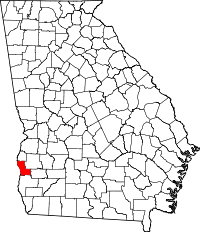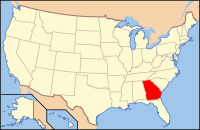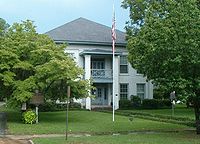- Clay County, Georgia
-
Clay County, Georgia Clay County Courthouse in Fort Gaines, Georgia
Location in the state of Georgia
Georgia's location in the U.S.Founded 1854 Seat Fort Gaines Largest city Fort Gaines Area
- Total
- Land
- Water
216.99 sq mi (562 km²)
195.21 sq mi (506 km²)
21.79 sq mi (56 km²), 10.04%PopulationEst.
- (2006)
- Density
3,180
17/sq mi (7/km²)Time zone Eastern: UTC-5/-4 Clay County is a county located in the U.S. state of Georgia. As of 2000, the population was 3,357. The 2007 Census Estimate shows a population of 3,207.[1] The county seat is Fort Gaines.[2]
Contents
History
The County is named in honor of Henry Clay, famous American statesman, member of the United States Senate from Kentucky and United States Secretary of State in the 19th century.
Clay was created by a February 16, 1854, act of the Georgia General Assembly using portions of Early and Randolph counties.
Geography
According to the 2000 census, the county has a total area of 216.99 square miles (562.0 km2), of which 195.21 square miles (505.6 km2) (or 89.96%) is land and 21.79 square miles (56.4 km2) (or 10.04%) is water.[3]
Major highways
Adjacent counties
- Quitman County, Georgia - north
- Randolph County, Georgia - northeast
- Calhoun County, Georgia - east
- Early County, Georgia - south
- Henry County, Alabama - west
- Barbour County, Alabama - northwest
Demographics
As of the census[4] of 2000, there were 3,357 people, 1,347 households, and 928 families residing in the county. The population density was 17 people per square mile (7/km²). There were 1,925 housing units at an average density of 10 per square mile (4/km²). The racial makeup of the county was 60.47% Black or African American, 38.43% White, 0.12% Native American, 0.27% Asian, 0.06% Pacific Islander, and 0.66% from two or more races. 0.95% of the population were Hispanic or Latino of any race.
There were 1,347 households out of which 25.70% had children under the age of 18 living with them, 40.70% were married couples living together, 23.40% had a female householder with no husband present, and 31.10% were non-families. 27.80% of all households were made up of individuals and 13.20% had someone living alone who was 65 years of age or older. The average household size was 2.45 and the average family size was 2.99.
In the county the population was spread out with 25.70% under the age of 18, 8.00% from 18 to 24, 21.00% from 25 to 44, 25.70% from 45 to 64, and 19.50% who were 65 years of age or older. The median age was 42 years. For every 100 females there were 83.30 males. For every 100 females age 18 and over, there were 78.50 males.
The median income for a household in the county was $21,448, and the median income for a family was $27,837. Males had a median income of $26,557 versus $17,083 for females. The per capita income for the county was $16,819. About 28.10% of families and 31.30% of the population were below the poverty line, including 43.40% of those under age 18 and 23.90% of those age 65 or over.
Education
Incorporated Cities
Unincorporated Towns
- Bellville
- Bethel
- Cotton Hill
- Days Crossroads
- Garnersville
- Harrisons Mill
- Jeff
- Jones Crossing
- Moores Crossroads
- Oakland
- Pecan
- Ricks Place
- Suttons Corner
- Watson Crossroads
- Zetto
Ghost Towns
See also
References
- ^ [1]
- ^ "Find a County". National Association of Counties. http://www.naco.org/Counties/Pages/FindACounty.aspx. Retrieved 2011-06-07.
- ^ "Census 2000 U.S. Gazetteer Files: Counties". United States Census. http://www.census.gov/tiger/tms/gazetteer/county2k.txt. Retrieved 2011-02-13.
- ^ "American FactFinder". United States Census Bureau. http://factfinder.census.gov. Retrieved 2008-01-31.
External links

Barbour County, Alabama Quitman County Randolph County 
Henry County, Alabama 
Calhoun County  Clay County, Georgia
Clay County, Georgia 

Early County Municipalities and communities of Clay County, Georgia City Town Ghost town Categories:- Georgia (U.S. state) counties
- Clay County, Georgia
- 1854 establishments in the United States
- Counties of the United States with African American majority populations
Wikimedia Foundation. 2010.


